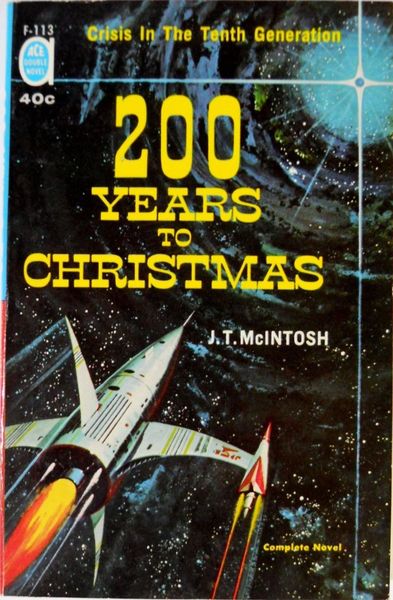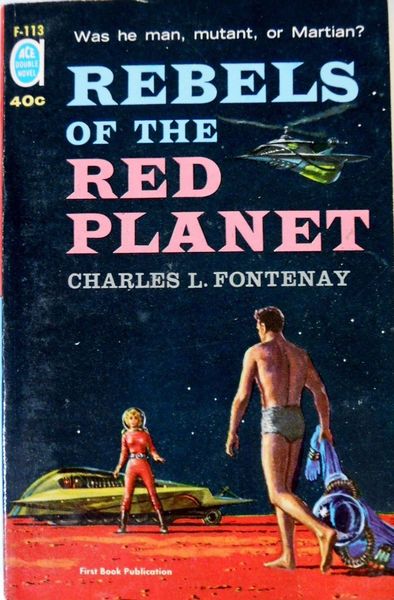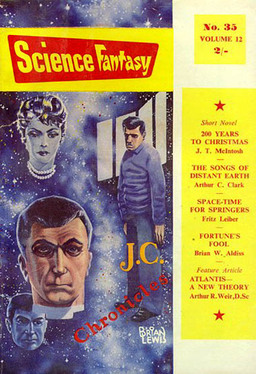Generation Ships and Martian Rebels: Rich Horton on 200 Years to Christmas by J. T. McIntosh and Rebels of the Red Planet by Charles L. Fontenay
 |
 |
In its 26-year history (1952-1978) the Ace Double series published over 520 SF novels and collections, including original work by some of the greatest SF writers of the 20th Century, such as Philip K. Dick, Jack Vance, Poul Anderson, Robert Silverberg, Samuel R. Delany, Fritz Leiber, Clifford D. Simak, John Brunner, Brian Aldiss, and many others.
Of course, it also published writers who aren’t nearly as well remembered today, like Margaret St. Clair, Kenneth Bulmer, Robert Moore Williams, Charles de Vet, William F. Temple, Robert Lowndes, Jack Sharkey, Jerry Sohl, and others. As you probably suspect, not all of those books are winners, but there’s plenty of interesting stuff buried in the dusty nooks and crannies of the Ace library.
And Rich Horton is the guy to find it. He has an ongoing series of reviews of Ace Doubles at his website, Strange at Ecbatan. Recently he talked about a forgotten Ace Double from 1961 by two writers I’m unfamiliar with: the generation-ship tale 200 Years to Christmas by J. T. McIntosh, and a novel of forbidden genetic experiments and rebellion on Mars, Rebels of the Red Planet by Charles L. Fontenay.

J. T. McIntosh, a pseudonym for Scottish writer James MacGregor (1925-2008), produced some 20 novels and roughly 100 short stories. Virtually none of his work is in print today, though Rich calls him “something of a guilty pleasure.”
200 Years to Christmas originally appeared in Science Fantasy [#35], in 1959, probably in the same form (i.e. I doubt the Ace Double is expanded). It’s a generation ship story, focussing on the problem of societal cohesion on a generation ship, as such reminiscent of Poul Anderson’s “The Troublemakers,” Ursula Le Guin’s “Paradises Lost,” and Stephen Baxter’s “Mayflower II,” among many others.
It is set over a few years at roughly the midpoint of a 400 year journey from Earth to another star. The inhabitants of the generation ship are not sure if human society has survived outside the ship — they left rather precipitously during a period of considerable social stress. The main character is Ted Benzil, a schoolteacher on the ship. His position is of considerable prestige. As the novel opens he is propositioned by a 15 year old girl (“startlingly nubile”) named Lila, but he gently rejects her, in favor of his long term older lover, Freddy Steel. The setup soon comes clear — the ship’s society is going through a libertine phase, but this is ending, to be replaced by a strictly Puritan phase.
During the years of Puritanism, the libertine views of the likes of Freddy Steel become anathema, and Freddy faces humiliation, while others face worse punishment. Ted Benzil is supposedly representative of a knowing middle way, but in fact he comes off as wishy-washy and not terribly courageous. He does eventually lose his job though, and he manages to find enough courage to help push things in the opposite direction, towards greater rationality. And of course he moves in the direction of Lila, while Freddy is presented as excessively libertine, just as the villains are excessively Puritan.
200 Years to Christmas is paired with Rebels of the Red Planet by Charles L. Fontenay, which Rich calls “rather a preposterous work.” Is it fun, at least?
Rebels of the Red Planet… [is] smoothly enough written and the heroes are good and the villains are really evull, so I admit I enjoyed the reading despite considerable reservations.
The story is set, no surprise, on Mars. Efforts to adapt humans to live more easily on the planet have been suppressed by evull corporate interests — if humans could live unaided on the planet they wouldn’t be forced to pay the spaceship lines that import material from Earth. But these efforts continue underground — some focussing on genetic alteration of humans to make them better adapted to Mars, others focussing on developing psychic abilities to, for example, allow teleportation of food directly from Earth.
The story opens with the beautiful Maya Cara Nome accompanying her fiance Nuwell Eli to a suspected outpost of illegal research. Nuwell is obviously evil, and weak, because he is a prosecutor. Maya is obviously good, because beautiful, and also because she was raised on the old Martians, but she is misguided. They discover quite shocking experiments performed by an old scientist, Goat Hennessy, who has vivisected embryos in feeble attempts as genetic manipulation.
Back in a major Martian city, Maya infiltrates a rebel center. There she meets the dynamic and handsome Dark Kensington, who should [be] in his 50s but seems to be 25 — with no memory of the past quarter century. We learn that both Maya and Dark have psychic powers. Maya is loyal enough to expose the rebel base, but many rebels escape. Maya tracks down Dark at another city, and falls in love with him. But Nuwell Eli follows her, and she is just weak enough to alert the authorities to Dark’s presence. He is shot and killed, and in despair Maya agrees to marry Nuwell after all.
But — but — those old Martians are something! It turns out Dark isn’t really dead, and he is able to join with the remaining rebels, the Old Martians, and some other victims just in time to save Maya. Save her? Well, it seems that Nuwell is whipping her to bring her to her senses, and to cure her or her obsession with Dark Kensington. Oh, what a baddy he is!
 Read Rich’s complete review here.
Read Rich’s complete review here.
200 Years to Christmas/Rebels of the Red Planet, by J. T. McIntosh and Charles L. Fontenay, was published by Ace Books in 1961. It is 81+143 pages, priced at 40 cents. The cover to the former is by Ed Valigursky; the artist for Rebels of the Red Planet is unknown (though it looks like Emsh to me).
200 Years to Christmas was reprinted in trade paperback by Wildside Press in 2007, and as an ebook by Gateway/Orion in 2014. Rebels of the Red Planet has had more luck; it appeared in paperback in the UK from Priory, and more recently has been reprinted by Wildside Press (2007), Resurrected Press (2010), Spastic Cat Press (2013), and Armchair Fiction (2013). An ebook edition appeared in 2015 from Start Publishing.
Our recent coverage of Ace Doubles includes:
Star Pirates and Cyborg Games: Rich Horton on The Star Virus by Barrington J. Bayley and Mask of Chaos by John Jakes
Invaders of Pluto, and Brain Stealers of Mars: Rich Horton on The Ultimate Weapon and The Planeteers by John W. Campbell
Space Barbarians and Uranium Mining on Mars: Rich Horton on Empire of the Atom by A. E. Van Vogt and Space Station #1 by Frank Belknap Long
Dorsai and Secret Psi Powers: Rich Horton on The Genetic General/Time to Teleport by Gordon R. Dickson
Space Stations With Secret Passages, and Snow White in Space: Rich Horton on Sanctuary in the Sky by John Brunner/The Secret Martians by John Sharkey
Parallel Universes and Space Marines: Rich Horton on The Games of Neith by Margaret St. Clair/The Earth Gods are Coming by Kenneth Bulmer
The Problem With Marion Zimmer Bradley: Rich Horton on Falcons of Narabedla/The Dark Intruder
King of the Fourth Planet/Cosmic Checkmate by Robert Moore Williams and Charles V. De Vet & Katherine MacLean
See all of our recent Vintage Treasures here.
I’d have been embarrassed to buy that Rebels of the Red Planet.
That cover!
Who on earth made the decision to use that as the art?
But what fun to see these vintage covers.
Major,
That’s hardly the most embarrassing SF cover of 1961… far from it! The only difference here is that it’s the guy showing some skin, and the woman who’s fully dressed.
I do love these old covers, though. Frequently more than the novels.